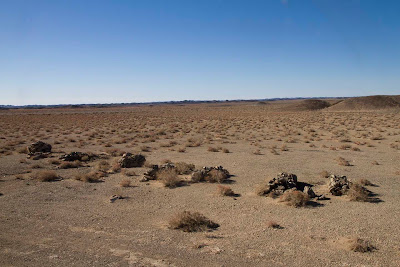Mongolia | Gov-Altai Aimag | Atas Bogd Uul
Crossing gravel flats with Atas Bogd Uul in the far distance (click on photos for enlargements)
Pass through the Arslan Khairkhan Hills
Faint trace of the ancient caravan trail—at one time probably a northern extension of the Silk Road—running between Atas Bogd Uul and Inges Uul.
Stone tripod used for cooking: a pot is placed on the top.
Local herdsmen claim that Mongolian caravan men never used permanent pot rests like this. They would use three stones as a temporary pot holder, but they would always knock the stones aside before they moved on. These permanent pot holders, claim the local camel guys, were used by Chinese caravan men who traveled on the trail back at the end of the nineteenth century or earlier.
8842-foot Atas (Male Camel) Bogd Uul
Ranger station south of Inges Uul where we stayed for two days
Ranger Station
6936-foot Inges (Female Camel) Uul, just to the east of Atas Bogd Uul. Inbetween Atas Bodg Uul and Inges Uul is Botgos (young camel) Uul (not visible on this photo).
Horns of the so-called Marco Polo sheep (Ovis ammon polii). They are common around Atas Bogd and Inges mountains.
Spring near where we camped
This was the first water source we encountered after leaving our starting point at Zakhyn Us 112 miles to the north, as the crow flies (longer by our route). We had to carry enough water on our camels for the five and half day trip here. The oasis around the spring is frequented by a Gobi Bear, whose sign we saw everywhere. The tracks of wolves, sheep, and wild asses were also seen around the spring.
Site of a famous 1938 battle between Mongolian border guards and the notorious Kazakh bandit and warlord Osman. In the 1930s and 40s Osman roamed the steppe and deserts of northern Xinjiang Province, China, making periodic raids into Mongolia to seize livestock and women.
At least seven Mongolian border guards were killed in the battle and buried on site. Their graves can be seen here.
Monument to the battle
Sister Dulya, camp boss on the trip, preparing boortsog (fried bread) at the ranger station for our 112 mile trip (as the crow flies) back to Zakhyn Us, just east of Eej Khairkhan Mountain.
Solongo, chief cook and assistant camel wrangler on the trip, preparing boortsog.
After a two day rest our camels were raring to get back home, 112 miles to the north.
Sister Dulya, still looking stylish after eight days on the trail, was raring to get back to Ulaanbaatar. First we had six long days of travel by camel to get back to our Starting Point at Zakhyn Us.



















